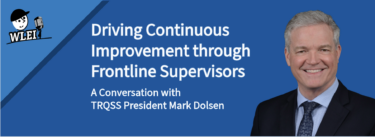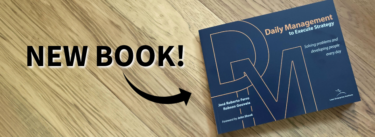A key tenet of any lean transformation — and what ultimately makes an organization’s continuous improvement efforts more successful — is a robust culture of systematic problem-solving at every level. The problem-solving process, in effect, is the formalization of PDCA (plan-do-check-act) every day and everywhere, including the shop floor, care unit, or office. That is one of the secrets to Toyota’s success which many organizations are trying to replicate.
Despite the central role problem-solving plays in the success of any lean effort, many organizations struggle to achieve a discipline in their problem-solving. Ideally, workers follow a scientific method and discipline when identifying problems, finding their actual sources, and coming up witheffective solutions.
One increasingly popular method for engaging employees in regular problem-solving activity is the “huddle,” a daily, standup, peer-to-peer group discussion. Huddle discussions typically last about 5-10 minutes in front of a huddle board on which the group leader or team members list problems and ideas for improvements and the leader tracks activity and results.
Too often, though, problem-solving in the huddle tends to get fast-tracked in favor of quick identification of problems and acceptance of solutions. “The random picking of problems that people in the work flow see doesn’t necessarily add up to the needed improvements in overall results,” says David Verble, a lean practitioner and lead instructor for LEI’s new workshop Coaching Problem Solving in Huddles and Team Meetings.
For instance, if the primary business goals of a healthcare organization are patient care, patient safety, and safety of the staff, huddle leaders and coaches should be guiding participants toward identifying problems that affect those areas. Instead, however, huddles tend to target problems that are immediate the members’ concerns about perceived waste or unnecessary effort but seldom have direct links to performance in terms of those priorities.
Huddle Pitfalls
As more service and industrial companies use the popular huddle board approach for continuous improvement activity, team leaders and coaches need to be aware of the pitfalls involved, Verble warns. “Often what’s picked up as a problem may be a nuisance or an inconvenience. There is an attempt to make a general link between these problems and the priorities of the company. As a result, it is mostly luck if it actually makes a contribution to the overall performance of the work the people are involved in.”
In his lean work with many organizations, Verble has observed that the problem identification process begins when an employee posts an “improvement ticket” describing a problem condition, or points out a problem during the huddle.
Unfortunately, problem solving usually proceeds based on partial knowledge and assumptions, not verified facts. “Often there is little effort to explore the problem more deeply, to ask what the team knows more specifically about what is happening, and ask what should be happening in the way the work is done. That’s what is needed to get a more precise and actionable description of the problem,” Verble says.
“There is a leap from problem recognition to solution without taking time to determine the real problem or its cause. This is not the kind of fact-based problem solving that Toyota demands for deciding countermeasures and proposing improvements,” adds Verble, a former manager of Human Resource Development for North American Manufacturing at Toyota’s Georgetown, KY plant and its manufacturing headquarters in Erlanger, KY.
Countermeasures
He recommends that huddle leaders and coaches guide the group in a systematic approach to examining each problem members decide is worth following up. This includes finding out exactly when the problem occurs and under what conditions, including who has observed it and how often. For example, a huddle team may identify a selection of three or more problems, investigate their occurrences, and report back. Then the group can decide which problems warrant priority action.
“One approach is to let the team spend five minutes discussing each problem over a week’s time to come up with five problems,” Verble suggests. “Then they can prioritize them by talking about which is having the greatest effect on their performance before they start talking about what to do about them.”
A scientific approach should be followed to determine the cause of the condition. “After the team observes or gathers data to more precisely define the problem, they need to establish a sound cause and relationship, before deciding what needs to be changed,” Verble says. This involves identifying potential causes, narrowing to most likely causes and observing or doing Rapid Learning Experiments to find and confirm true cause. This gives huddle members a sound basis for deciding what actions need to be taken to change the situation, and what resources and approvals will be needed to effect the change.
This is a totally different approach to problem-solving than what Verble terms “a jump from an impression of a problem to a solution. It’s human nature for us to rush to a solution for a problem based on what we think we know,” he adds. “The brainstorming of ‘solutions’ in these meetings seldom gets at what’s really going on and what’s causing the problem.”
Ultimately, although the huddle or team participants come up with the problems and determine the actions needed to solve them, huddle leaders and coaches need to guide them along the disciplined PDCA problem solving path– as opposed to the easier “fast track”– to problem-solving, Verble believes. “Leaders and coaches have the primary role of slowing the rush to ‘fast thinking’ problem-solving through asking the right kind of questions about the right things at the right time,” he says.
Take the next step:
Take “Coaching Problem Solving in Huddles and Team Meetings,” a new workshop with David Verble, to get practical advice for guiding teams away from “fast thinking” to true PDCA. Get better results from huddles and team meetings. See what you’ll learn and register.





